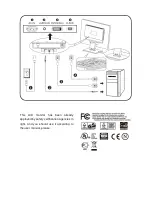
16
Monitor
MultiSync
¨
LCD1970NX Notes
Specifi cations
Monitor
LCD Module
Diagonal :
19.0 inch
Active matrix; thin Þ lm transistor (TFT)
Viewable Image Size :
19.0 inch
liquid crystal display (LCD); 0.294 mm dot
Native Resolution (Pixel Count) :
1280 x1024 pitch; 230cd/m
2
white luminence;
800:1 contrast ratio, typical
Input Signal
Video :
ANALOG 0.7 Vp-p/75 Ohms
Digital Input: DVI
Sync :
Separate sync. TTL Level
Horizontal sync. Positive/Negative
Vertical sync. Positive/Negative
Composite sync. Positive/Negative
Sync on Green (Video 0.7Vp-p and Sync Negative 0.3Vp-p)
Display Colors
16,777,216
Dependent on display card used.
Maximum
Left/Right :
88¡/88¡ (CR>10)
Viewing Angles
Up/Down :
88¡/88¡ (CR>10)
Synchronization
Horizontal :
31.5 kHz to 81.1 kHz
Automatically
Range
Vertical :
56.0 Hz to 75.0 Hz
Automatically
Resolutions Supported
720 x 400*
1
:VGA text
Some systems may not support all modes listed.
640 x 480*
1
@ 60 Hz to 75 Hz
800 x 600*
1
@ 56 Hz to 75 Hz
832 x 624*
1
@ 75 Hz
1024 x 768*
1
@ 60 Hz to 75 Hz
1152 x 870*
1
@ 75 Hz
1280 x 1024 @ 60 Hz to 75 Hz ....................NEC DISPLAY SOLUTIONS cites
recommended resolution at 60 Hz for
optimal display performance.
Active Display Area Horizontal : 376.3 mm/14.8 inches
Vertical : 301.1 mm/11.9 inches
USB Hub
I/P:
USB SpeciÞ cation Revision 2.0
Port:
Upstream 1
Downstream 4
Load Current:
Maximum 0.5A per port
Power Supply
100 Ð 240 V~ 50/60 Hz
Current Rating
1.2 Ð 0.6A
Dimensions
412.5 mm (W) x 386.5-496.5 mm (H) x 220.0 mm (D)
16.2 inches (W) x 15.2-19.5 inches (H) x 8.7 inches (D)
Weight
8.1 kg
17.9 lbs
Environmental Considerations
Operating Temperature :
5¡C to 35¡C/41¡F to 95¡F
Humidity :
30% to 80%
Feet :
0 to 10,000 Feet
Storage Temperature :
-10¡C to 60¡C/14¡F to 140¡F
Humidity :
10% to 85%
Feet :
0 to 40,000 Feet
*
1
Interpolated Resolutions: When resolutions are shown that are lower than the pixel count of the LCD module, text may appear different. This is
normal and necessary for all current ß at panel technologies when displaying non-native resolutions full screen. In ß at panel technologies, each dot on
the screen is actually one pixel, so to expand resolutions to full screen, an interpolation of the resolution must be done.
NOTE: Technical speciÞ cations are subject to change without notice.
Specifi cations
-continued
















































